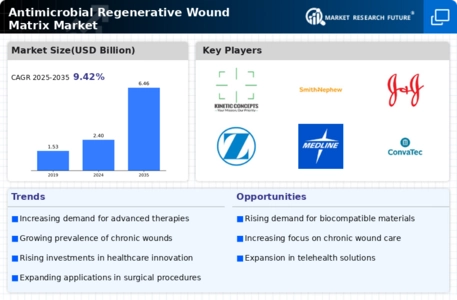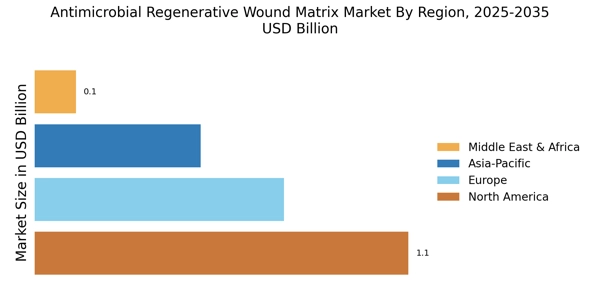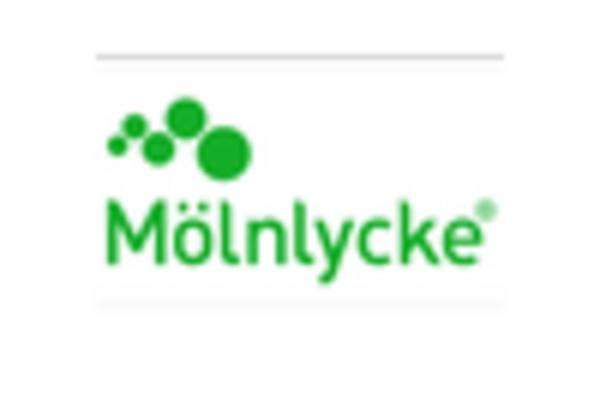Increasing Geriatric Population
The aging population is a significant driver of the Antimicrobial Regenerative Wound Matrix Market, as older adults are more susceptible to chronic wounds and infections. With the global demographic shift towards an older population, the demand for effective wound care solutions is expected to rise. Elderly individuals often experience slower healing processes, making the use of antimicrobial regenerative matrices essential for promoting recovery. Market analyses indicate that the geriatric segment will contribute substantially to the overall growth of the wound care market, with projections suggesting a notable increase in product demand. As healthcare systems adapt to the needs of this demographic, the Antimicrobial Regenerative Wound Matrix Market is likely to see enhanced investment and innovation.
Rising Incidence of Chronic Wounds
The Antimicrobial Regenerative Wound Matrix Market is experiencing growth due to the increasing prevalence of chronic wounds, such as diabetic ulcers and pressure sores. These conditions often require advanced treatment options to promote healing and prevent infections. According to recent data, chronic wounds affect millions of individuals worldwide, leading to a heightened demand for effective wound care solutions. The need for antimicrobial properties in wound matrices is particularly critical, as these products help reduce the risk of infection, thereby improving patient outcomes. As healthcare providers seek to enhance their treatment protocols, the Antimicrobial Regenerative Wound Matrix Market is poised to expand significantly, driven by the necessity for innovative and effective wound management solutions.
Growing Awareness of Infection Control
Infection control remains a paramount concern in healthcare settings, propelling the Antimicrobial Regenerative Wound Matrix Market forward. Healthcare professionals are increasingly aware of the implications of infections in wound healing, which can lead to complications and prolonged recovery times. This awareness has led to a surge in the adoption of antimicrobial wound care products, as they are designed to minimize the risk of infection. The market is projected to witness substantial growth, with estimates suggesting a compound annual growth rate of over 10% in the coming years. As hospitals and clinics prioritize infection prevention strategies, the demand for antimicrobial regenerative wound matrices is likely to rise, further solidifying their role in modern wound care.
Technological Innovations in Wound Care
Technological advancements are reshaping the Antimicrobial Regenerative Wound Matrix Market, introducing new materials and methods that enhance wound healing. Innovations such as bioengineered matrices and smart wound dressings are gaining traction, offering improved efficacy and patient comfort. These technologies not only facilitate faster healing but also provide real-time monitoring of wound conditions, which is crucial for timely interventions. The integration of nanotechnology and biotechnology in wound care products is expected to drive market growth, as these innovations offer superior antimicrobial properties and biocompatibility. As healthcare providers increasingly adopt these advanced solutions, the Antimicrobial Regenerative Wound Matrix Market is likely to expand, reflecting the ongoing evolution of wound management practices.
Regulatory Support for Advanced Wound Care Products
Regulatory bodies are increasingly supporting the development of advanced wound care products, which is beneficial for the Antimicrobial Regenerative Wound Matrix Market. Streamlined approval processes and guidelines for antimicrobial products are encouraging manufacturers to innovate and bring new solutions to market. This regulatory environment fosters competition and enhances product availability, ultimately benefiting patients and healthcare providers. As regulations evolve to accommodate the latest advancements in wound care technology, the market is expected to experience robust growth. The emphasis on safety and efficacy in product development aligns with the industry's goals, suggesting a promising future for antimicrobial regenerative wound matrices as essential components of modern wound management.


















Leave a Comment